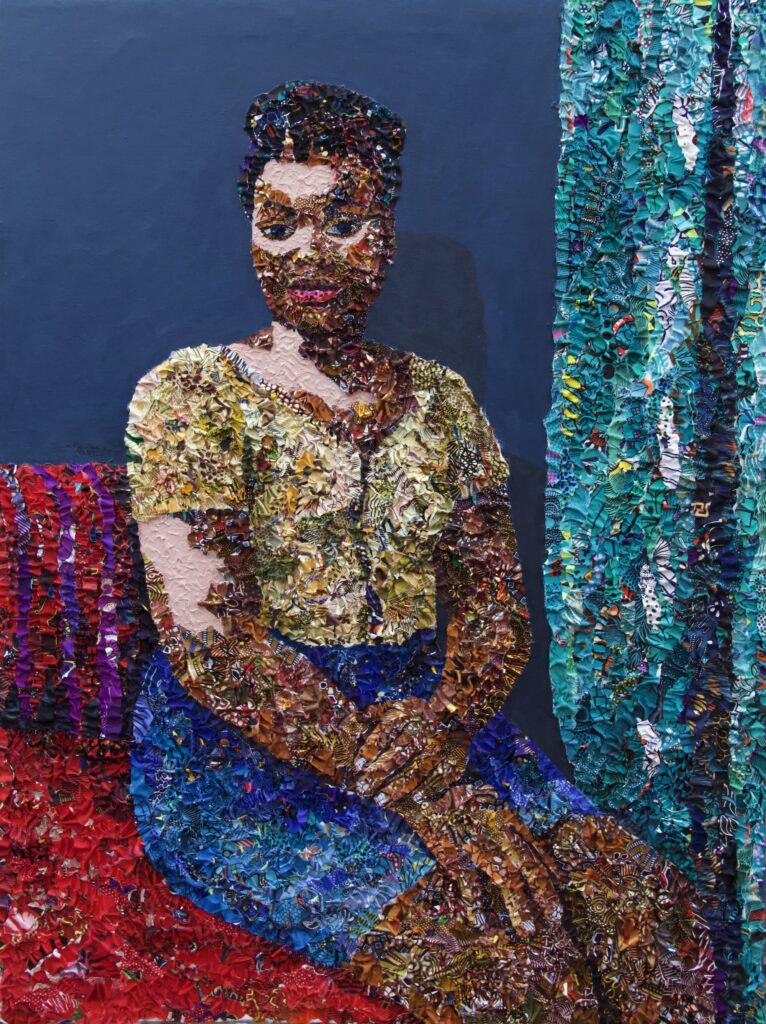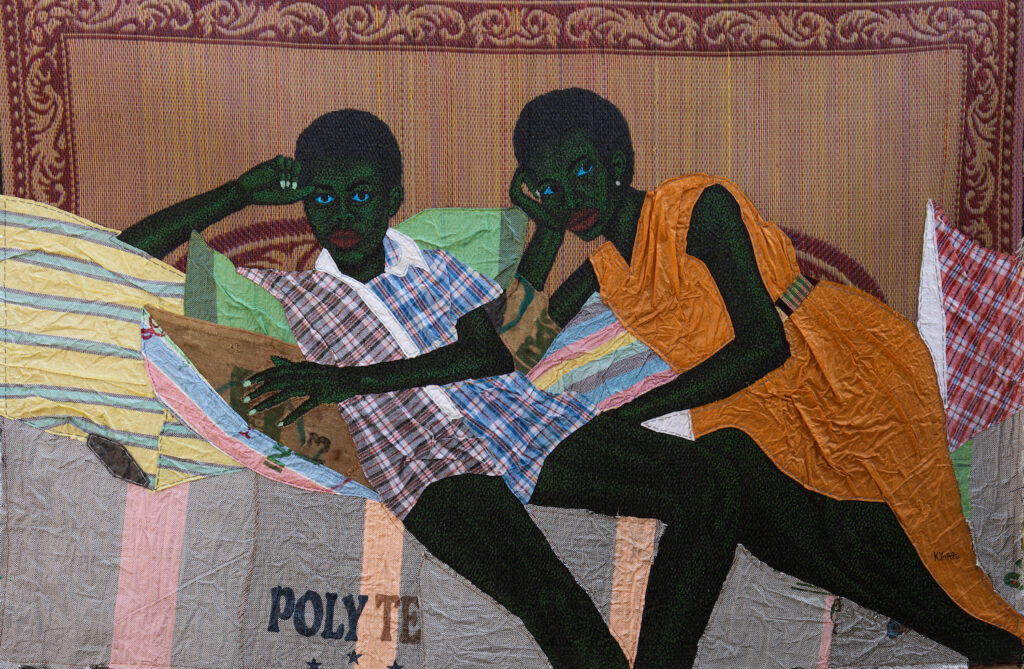21 September—2 November, 2024
A Closer Look
70 Square Metres, 41 Hengshan Road, Shanghai, China
Shanghai, 70 Square Metres
Overview
SHANGHAI—Gallerist Pearl Lam is thrilled to present the exhibition A Closer Look at 70 Square Metres, her new gallery space at 41 Hengshan Road. Through the works of 11 international artists, this show offers an intriguing exploration of individual and societal consciousness, an inevitable duality underlying human disposition, world outlook, and conduct.
Abdur Rahman Muhammad’s body of work captures the plight of youths looking to migrate overseas where they believe greater opportunities and prospects await them. His painting Orange Essence presents a male figure holding a worn “Ghana Must Go” bag, a common woven plastic travel bag that has become a symbol of migration. The colourful bag is a tangible link to his roots and evokes nostalgia and determination. Elements of hope and promise is deducible in the symbolic use of green for the subject’s T-shirt, while orange used in the background connotes his energy, creativity, and zeal. The “Ghana Must Go” bag captured here holds all the figure’s dreams and belongings as he embarks upon his relocation. The impasto painting technique is used in depicting the subject’s skin and projecting it from the background.
Adjei Tawiah is known for his unique approach of incorporating nylon sponge in his vivid figurative representations, adding texture and dimension to his paintings. His unique technique, which he refers to as “sponge martial”, is inspired by the cleansing of his mother’s corpse in the mortuary. The idea of cleansing is further seen in his use of vibrant colours that represent the bright moments that follow the darker times in life. The artist intends for his work to serve as a source of inspiration to humanity through times of affliction. His work titled Lip Service effectively captures the essence of the female subject, inviting the viewer to ponder on her emotions and intentions.
Ayobola Kekere-Ekun, using a technique known as quilling (in which strips of paper are individually shaped to create forms), relives her experiences and observations in subjects relating to gender, mythology, memory, and trauma. Her piece titled Threshold III (from her She and I series) traces her personal journey of healing through childhood traumas referencing old family photographs, conversations with family members, and pop culture. Ajah Confessional IX and Oya Confessional I are two works from a series titled The Real Housewives of Old Oyo, in which the artist interrogates issues of male dominance in Yoruba mythology and traditional beliefs. Here, male deities are often projected as relevant and superior while female deities are depicted as petty and preoccupied by domestic squabbles. Kekere-Ekun considers the discrepancies striking and worthy of exploration.
Cornelius Annor paints figurative works that express togetherness and intimacy within domestic and community spaces. His subjects stem from memory and personal history in Ghana, including his exploits in photography. He employs traditional Ghanian textiles with which he forms textured patterns to establish an atmosphere of layered memories, emotions, and experiences. The work titled Akwaaba (meaning “welcome home” or “welcome back” in Akan) contemplates salutations and recognition accorded the majority of Ghana’s diaspora in the 1980s and 1990s. These are gestures of love, respect, and solidarity towards the returnees considered to have laboured abroad for greener pastures. Ma ye nkasa, meaning “let’s talk” or “let’s have a conversation”, underlines the intimacy shared in families and the power of cooperation amongst family members. Similarly, Me Yonko, meaning “my friend”, projects a shared elegance and style by two young men in hats and suits, while conveying a deeper contemplation of the true definition of friendship.
Deborah Segun adopts a deconstructive approach to project fragmented female faces and figures as silhouettes in contemplation and repose. Her paintings Sitting Still and Safe Haven are rendered with a minimalist flatness, which offers an accompanying delicateness. An advocate of self-awareness and well-being, she encourages women to strive towards self-actualization while referencing her personal experience. Her works speak of her evolvement and adaptability over time as an artist.
Isshaq Ismail has a unique abstract and figurative approach to painting, which he terms “infantile semi- abstraction”. His usually impastoed and vibrant palette addresses human conditions in postmodernity, including conversations around beauty sparked by his grotesque representation of human figures. This deviation from the norm is a form of protest that fills the void for the voiceless undermined by systemic socio-cultural and political orders. Ismail’s Radiant Persona series in charcoal attempts to conjure characters in a state of limbo, isolation, desire, and hope, while borrowing from the concept of black and white photography. Growing up in charcoal was prevalent for cooking at home and hence became one of the earliest mediums Ismail explored; his recent adoption of it serves to help the artist relive his earliest memories as well as deepen his foundational interest in drawing.
James Mishio’s series, including a painting titled Ghetto Boy, examines themes of misunderstanding and societal judgment. Here, a young man is often misread and pre-empted as a probable never-do-well owing to his distinctive dread hairstyle, which is partially concealed by a bucket hat he wears as though to shield himself from scrutiny. However, his smile and seemingly brilliant nature contrast with the superficial judgments cast upon him, while revealing an inner strength and resilience in the face of his identity challenge. Reading in between the Lines is a mixed-media painting that blends oil, acrylic, and fabric to create a rich texture, presenting a stylishly dressed solitary subject in a contemplative mood. The indiscriminately stacked pile of books on the floor next to him has the effect of depicting the figure as someone with a harmonious blend of intellectual curiosity and personal passion. Through this work, Mishio wishes to convey the importance of making thoughtful decisions.
Kwaku Yaro’s works emphasise the importance of recycling as he employs disused materials such as bags, mats, and fabrics to create his beautiful works, thus pushing notions of materiality in art beyond conventional archetypes. The artist’s passion for fashion is evident in how the materials are cut and sewn into the clothing of his subjects. He also uses the pointillism technique to create depth and richness in his compositions while portraying his muses in fantasised refined clothing to reflect their affluence. The deliberate abandonment of the texts on the bags and materials in his artwork draws the observer’s attention to the history behind these materials. Panyin and Kakra portrays identical twins in harmonious poses with their rather mismatched or opposing attire emphasising their unique personalities.
Marcellina Akpojotor’s richly textured and layered collages and traditional paintings explore femininity, personal identity, and issues surrounding women empowerment in contemporary society. Working largely with discarded pieces of Ankara fabric, she investigates the politics of the material as a cultural signifier and a conduit for memory and shared energy. Dear Aghoghome is a portrait of a young teenage family member, adapted as the artist’s younger-self approaching womanhood. The subject’s direct gaze suggests being lost in introspection, as she contemplates the changing phases of her life and passage to womanhood.
Mobolaji Ogunrosoye specialises in photography and collage, utilising these mediums to explore distortion and the shades of contrasting emotions found within images of Nigerian and other black women. Her portraits are characterised by multilayer collages, incorporating a process of burning and cutting to create depth in revealing underlying layers of images. Her Portraits series, first developed in 2021, incorporates coffee granules as an important element within each work. Her triptych piece titled Portraits | Cecilia, in Observation appears as a linear development of the portrait of a black woman from simple curvy smokey impressions to a complete and identifiable subject.
Moses Hamborg, likened to painters of the Renaissance, sustains his intuitive dedication to both subject and craft. To him, classical figuration is a source of endless inspiration. In Mariama & Moumi, the viewer encounters the artist’s bold and direct brushstrokes, capturing a moment of repose for two vibrantly dressed Senegalese women against a muted blue grey background; they are seated with their bodies resting against each other on a single chair. In Lamine, Hamborg deftly captures highlights and contrasts deep tones with the blank white canvas through soft, atmospheric contours and edges.
About 70 Square Metres
70 Square Metres is a brand-new gallery space in Shanghai by gallerist Pearl Lam that will house artist residency programmes and provide an opportunity for emerging non-residency artists to exhibit their work. Located in the historic former French Concession, the new space represents Lam’s ongoing dedication to nurturing creativity and promoting underrepresented voices while fostering cross-cultural dialogue and understanding. The residency programme underscores the gallerist’s ongoing commitment to strengthen connections between the East and West, as well as other areas of the world such as Africa. Lam believes that art transcends borders with its power to communicate with people of all cultures and nations.
Pearl Lam, Founder of 70 Square Metres, says, “By welcoming artists from various countries, disciplines, and stages in their careers, we create a vibrant environment where ideas and different perspectives flourish. This initiative not only enriches our community but also contributes to the broader cultural landscape. We provide residents with the time, space, and resources they need to dive deeply into their work, explore new mediums, and create innovative and expressive works.”
Viewing by appointment only. Please contact visit@70sqm.com.
Venue: 70 Square Metres, G/F, 41 Hengshan Road, Shanghai, China 200031








